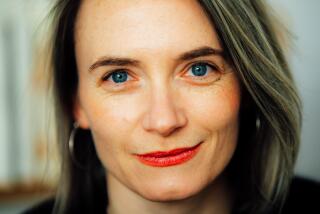Charting the Frontier Called Age : AGE<i> by Hortense Calisher (Weidenfeld & Nicolson: $14.95; 128 pp.) </i>
- Share via
What to make of this slender novel/novella by Hortense Calisher? It is as fragile and paradoxical as the state of its protagonists, a spunky pair--he a poet, she an architect--who are confronting the last frontier: the uncharted territory of age.
These two, Rupert and Gemma, have made a pact in their 70s to keep separate journals of their life together. The journals are to be read only when one of them dies, which means only the survivor gets to read both. It’s a curious, not entirely logical idea, troubling even to the characters as characters.
It allows Calisher the conceit of giving us introspective views of the same life seen through different angles of a shared prism. In this case, it’s two views of a marriage in which events by now are few and mostly unremarkable. The device, an opportunity for close examination of the emotional process of aging, is oddly used.
Calisher focuses on the minutiae of living--the descending spiral of energy and autonomy, the extended concerns that creep up on people as age treacherously advances.
Not a bad approach, theoretically. This zeroing in on the particular can, and often does, have echoes in the universal. But Calisher is hit and miss. Too much of the time she focuses on minutiae that remain minute. Nor does she achieve enough distinction between the voices of Gemma and Rupert.
Though she claims to alternating chapters being written by these alternating members of the couple, they sound exactly alike, which is frequently confusing.
Much more problematic, however, is Calisher’s idiosyncratic style. She writes in strangely unfinished sentences. Without verbs. Like this. Usually. Too often.
While striving for simplicity, this overaffection for truncated phrases becomes merely eccentric. Just as perplexing is the fact that she’ll careen from something as exquisite as “those sunbelt clothes that look like food coloring” or “the sun splashes all with afternoon paint” to something as improbably awkward as “ ‘Now you tell me. What you’ve been up to. I’ve told you. What I.’ ”
On balance, the cleverness of “cheese smacking of the best cholesterol,” the perception of “What youth does is make me uncertain I am still in the world” or the happy economy of “It’s where you say what you should never think” do not make up for too much of the rest of the self-conscious writing. There is an unshakable awareness here of a writer at work.
Elizabeth Forsythe Hailey’s “Joanna’s Husband and David’s Wife” utilized the similar idea of a husband and wife contributing to a single memoir (in this case a husband comes across his wife’s record of their life together and injects his own vastly different perceptions of it). While it is not the same story and has nothing to do with age, there was a color and individuality in those characters that we miss in Calisher’s manicured volume. Too much gentility is part of it, but “Age” natters where it should speak. It is embroidery rather than a work of the heart--or to borrow Rupert’s words: “A progression of replicas almost without matter, without devotion to any original.”
More to Read
Sign up for our Book Club newsletter
Get the latest news, events and more from the Los Angeles Times Book Club, and help us get L.A. reading and talking.
You may occasionally receive promotional content from the Los Angeles Times.









